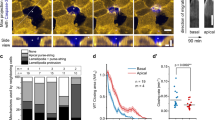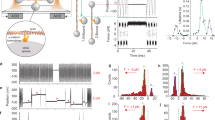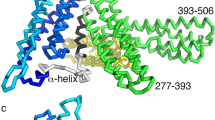Abstract
Epithelial tissues maintain a robust architecture which is important for their barrier function, but they are also remodelled through the reorganization of cell–cell contacts. Tissue stability requires intercellular adhesion mediated by E-cadherin, in particular its trans-association in homophilic complexes supported by actin filaments through β- and α-catenin. How α-catenin dynamic interactions between E-cadherin/β-catenin and cortical actin control both stability and remodelling of adhesion is unclear. Here we focus on Drosophila homophilic E-cadherin complexes rather than total E-cadherin, including diffusing ‘free’ E-cadherin, because these complexes are a better proxy for adhesion. We find that E-cadherin complexes partition in very stable microdomains (that is, bona fide adhesive foci which are more stable than remodelling contacts). Furthermore, we find that stability and mobility of these microdomains depend on two actin populations: small, stable actin patches concentrate at homophilic E-cadherin clusters, whereas a rapidly turning over, contractile network constrains their lateral movement by a tethering mechanism. α-Catenin controls epithelial architecture mainly through regulation of the mobility of homophilic clusters and it is largely dispensable for their stability. Uncoupling stability and mobility of E-cadherin complexes suggests that stable epithelia may remodel through the regulated mobility of very stable adhesive foci.
This is a preview of subscription content, access via your institution
Access options
Subscribe to this journal
Receive 51 print issues and online access
$199.00 per year
only $3.90 per issue
Buy this article
- Purchase on Springer Link
- Instant access to full article PDF
Prices may be subject to local taxes which are calculated during checkout





Similar content being viewed by others
References
Knust, E. & Bossinger, O. Composition and formation of intercellular junctions in epithelial cells. Science 298, 1955–1959 (2002)
Nelson, W. J. Adaptation of core mechanisms to generate cell polarity. Nature 422, 766–774 (2003)
Thiery, J. P. Cell adhesion in development: a complex signalling network. Curr. Opin. Genet. Dev. 13, 365–371 (2003)
Lecuit, T. & Lenne, P. F. Cell surface mechanics and the control of cell shape, tissue patterns and morphogenesis. Nature Rev. Mol. Cell Biol. 8, 633–644 (2007)
Leckband, D. & Prakasam, A. Mechanism and dynamics of cadherin adhesion. Annu. Rev. Biomed. Eng. 8, 259–287 (2006)
Gates, J. & Peifer, M. Can 1000 reviews be wrong? Actin, α-Catenin, and adherens junctions. Cell 123, 769–772 (2005)
Sako, Y., Nagafuchi, A., Tsukita, S., Takeichi, M. & Kusumi, A. Cytoplasmic regulation of the movement of E-cadherin on the free cell surface as studied by optical tweezers and single particle tracking: corralling and tethering by the membrane skeleton. J. Cell Biol. 140, 1227–1240 (1998)
Yamada, S., Pokutta, S., Drees, F., Weis, W. I. & Nelson, W. J. Deconstructing the cadherin-catenin-actin complex. Cell 123, 889–901 (2005)
Cliffe, A., Mieszczanek, J. & Bienz, M. Intracellular shuttling of a Drosophila APC tumour suppressor homolog. BMC Cell Biol. 5, 37 (2004)
Adams, C. L., Chen, Y. T., Smith, S. J. & Nelson, W. J. Mechanisms of epithelial cell-cell adhesion and cell compaction revealed by high-resolution tracking of E-cadherin-green fluorescent protein. J. Cell Biol. 142, 1105–1119 (1998)
Cox, R. T., Kirkpatrick, C. & Peifer, M. Armadillo is required for adherens junction assembly, cell polarity, and morphogenesis during Drosophila embryogenesis. J. Cell Biol. 134, 133–148 (1996)
Muller, H. A. & Wieschaus, E. Armadillo, bazooka, and stardust are critical for early stages in formation of the zonula adherens and maintenance of the polarized blastoderm epithelium in Drosophila . J. Cell Biol. 134, 149–163 (1996)
Uemura, T. et al. Zygotic Drosophila E-cadherin expression is required for processes of dynamic epithelial cell rearrangement in the Drosophila embryo. Genes Dev. 10, 659–671 (1996)
Harris, T. J. & Peifer, M. The positioning and segregation of apical cues during epithelial polarity establishment in Drosophila . J. Cell Biol. 170, 813–823 (2005)
Tepass, U. & Hartenstein, V. The development of cellular junctions in the Drosophila embryo. Dev. Biol. 161, 563–596 (1994)
Oda, H., Tsukita, S. & Takeichi, M. Dynamic behaviour of the cadherin-based cell-cell adhesion system during Drosophila gastrulation. Dev. Biol. 203, 435–450 (1998)
Adams, C. L. & Nelson, W. J. Cytomechanics of cadherin-mediated cell-cell adhesion. Curr. Opin. Cell Biol. 10, 572–577 (1998)
Wiedenmann, J. et al. EosFP, a fluorescent marker protein with UV-inducible green-to-red fluorescence conversion. Proc. Natl Acad. Sci. USA 101, 15905–15910 (2004)
Kofron, M., Spagnuolo, A., Klymkowsky, M., Wylie, C. & Heasman, J. The roles of maternal α-catenin and plakoglobin in the early Xenopus embryo. Development 124, 1553–1560 (1997)
Torres, M. et al. An α-E-catenin gene trap mutation defines its function in preimplantation development. Proc. Natl Acad. Sci. USA 94, 901–906 (1997)
Vasioukhin, V., Bauer, C., Degenstein, L., Wise, B. & Fuchs, E. Hyperproliferation and defects in epithelial polarity upon conditional ablation of α-catenin in skin. Cell 104, 605–617 (2001)
Pilot, F., Philippe, J.-M., Lemmers, C. & Lecuit, T. Spatial control of actin organization at adherens junctions by the synaptotagmin-like protein Btsz. Nature 442, 580–584 (2006)
Kusumi, A., Sako, Y. & Yamamoto, M. Confined lateral diffusion of membrane receptors as studied by single particle tracking (nanovid microscopy). Effects of calcium-induced differentiation in cultured epithelial cells. Biophys. J. 65, 2021–2040 (1993)
Saxton, M. J. Single-particle tracking: the distribution of diffusion coefficients. Biophys. J. 72, 1744–1753 (1997)
Somogyi, K. & Rorth, P. Evidence for tension-based regulation of Drosophila MAL and SRF during invasive cell migration. Dev. Cell 7, 85–93 (2004)
Romero, S. et al. Formin is a processive motor that requires profilin to accelerate actin assembly and associated ATP hydrolysis. Cell 119, 419–429 (2004)
Bogdan, S., Stephan, R., Lobke, C., Mertens, A. & Klambt, C. Abi activates WASP to promote sensory organ development. Nature Cell Biol. 7, 977–984 (2005)
Kumar, S. et al. Viscoelastic retraction of single living stress fibers and its impact on cell shape, cytoskeletal organization, and extracellular matrix mechanics. Biophys. J. 90, 3762–3773 (2006)
Dutta, D., Bloor, J. W., Ruiz-Gomez, M., VijayRaghavan, K. & Kiehart, D. P. Real-time imaging of morphogenetic movements in Drosophila using Gal4-UAS-driven expression of GFP fused to the actin-binding domain of moesin. Genesis 34, 146–151 (2002)
Kametani, Y. & Takeichi, M. Basal-to-apical cadherin flow at cell junctions. Nature Cell Biol. 9, 92–98 (2007)
Abe, K. & Takeichi, M. EPLIN mediates linkage of the cadherin catenin complex to F-actin and stabilizes the circumferential actin belt. Proc. Natl Acad. Sci. USA 105, 13–19 (2008)
Bertet, C., Sulak, L. & Lecuit, T. Myosin-dependent junction remodelling controls planar cell intercalation and axis elongation. Nature 429, 667–671 (2004)
Classen, A. K., Anderson, K. I., Marois, E. & Eaton, S. Hexagonal packing of Drosophila wing epithelial cells by the planar cell polarity pathway. Dev. Cell 9, 805–817 (2005)
Izumi, G. et al. Endocytosis of E-cadherin regulated by Rac and Cdc42 small G proteins through IQGAP1 and actin filaments. J. Cell Biol. 166, 237–248 (2004)
Kartenbeck, J., Schmelz, M., Franke, W. W. & Geiger, B. Endocytosis of junctional cadherins in bovine kidney epithelial (MDBK) cells cultured in low Ca2+ ion medium. J. Cell Biol. 113, 881–892 (1991)
Troyanovsky, R. B., Sokolov, E. P. & Troyanovsky, S. M. Endocytosis of cadherin from intracellular junctions is the driving force for cadherin adhesive dimer disassembly. Mol. Biol. Cell 17, 3484–3493 (2006)
Cavey, M. & Lecuit, T. Imaging Cellular and Molecular Dynamics in Live Embryos Using Fluorescent Proteins (ed. Dahmann, C.) (Humana, 2008)
Tsuji, A. & Ohnishi, S. Restriction of the lateral motion of band 3 in the erythrocyte membrane by the cytoskeletal network: dependence on spectrin association state. Biochemistry 25, 6133–6139 (1986)
Qian, H., Sheetz, M. P. & Elson, E. L. Single particle tracking. Analysis of diffusion and flow in two-dimensional systems. Biophys. J. 60, 910–921 (1991)
Oda, H. & Tsukita, S. Real-time imaging of cell-cell adherens junctions reveals that Drosophila mesoderm invagination begins with two phases of apical constriction of cells. J. Cell Sci. 114, 493–501 (2001)
Axelrod, D., Koppel, D. E., Schlessinger, J., Elson, E. & Webb, W. W. Mobility measurement by analysis of fluorescence photobleaching recovery kinetics. Biophys. J. 16, 1055–1069 (1976)
Konig, K. Multiphoton microscopy in life sciences. J. Microsc. 200, 83–104 (2000)
Acknowledgements
We thank J. M. Philippe for preparing the E-cad::EosFP construct, C. Picard for contribution to the α-Cat RNAi studies, and everyone who provided us with reagents, especially H. Oda, G. Nienhaus, D. Kiehart, C. Klaembt, P. Rørth and E. Wieschaus. We also thank all members of the Lecuit and Lenne laboratories for discussions and comments on the manuscript. This work was supported by the CNRS, the Fondation Schlumberger pour l’Education et la Recherche (FSER), the ANR-Blanc together with P.-F.L.. M.C. was supported by the FSER and the Association pour la Recherche sur la Cancer (ARC). M.R. is supported by a Bourse Région PACA-Entreprise (Amplitude Systems).
Author Contributions T.L. planned the project and analysed the experiments together with M.C., M.R. and P.-F.L.; M.C. conducted the experiments except for the nano-ablations, which were performed by M.R.; P.-F.L developed the nano-ablation system together with M.R. and the data quantification procedures with M.C. The manuscript was written by T.L. and all authors commented on it.
Author information
Authors and Affiliations
Corresponding authors
Supplementary information
Supplementary Information
The file contains Supplementary Methods, Supplementary Figures S1-S3 with Legends and Legends to Supplementary Movies S1-S3. (PDF 1215 kb)
Supplementary Movie S1
The file contains Supplementary Movie S1. Live confocal imaging of E-cad ::GFP embryos used to measure interspot diffusion coefficients. Wild type embryo, 15-20 min after the onset of gastrulation. (MOV 4322 kb)
Supplementary Movie S2
The file contains Supplementary Movie S2. Live confocal imaging of E-cad ::GFP embryos used to measure interspot diffusion coefficients. Latrunculin-A-injected embryo, approximately 10-15 min after onset of gastrulation. (MOV 4736 kb)
Supplementary Movie S3
The file contains Supplementary Movie S3. Live confocal imaging of E-cad ::GFP embryos used to measure interspot diffusion coefficients. α-Cat RNAi-injected embryo, approx 30min after onset of gastrulation. (MOV 5171 kb)
Rights and permissions
About this article
Cite this article
Cavey, M., Rauzi, M., Lenne, PF. et al. A two-tiered mechanism for stabilization and immobilization of E-cadherin. Nature 453, 751–756 (2008). https://doi.org/10.1038/nature06953
Received:
Accepted:
Published:
Issue Date:
DOI: https://doi.org/10.1038/nature06953
This article is cited by
-
Exosomes derived from adipose tissues accelerate fibroblasts and keratinocytes proliferation and cutaneous wound healing via miR-92a/Hippo-YAP axis
Journal of Physiology and Biochemistry (2024)
-
Dynamics and functions of E-cadherin complexes in epithelial cell and tissue morphogenesis
Marine Life Science & Technology (2023)
-
Embryo-scale epithelial buckling forms a propagating furrow that initiates gastrulation
Nature Communications (2022)
-
Cellular dynamics of EMT: lessons from live in vivo imaging of embryonic development
Cell Communication and Signaling (2021)
-
Regulation of ARHGAP19 in the endometrial epithelium: a possible role in the establishment of uterine receptivity
Reproductive Biology and Endocrinology (2021)
Comments
By submitting a comment you agree to abide by our Terms and Community Guidelines. If you find something abusive or that does not comply with our terms or guidelines please flag it as inappropriate.



